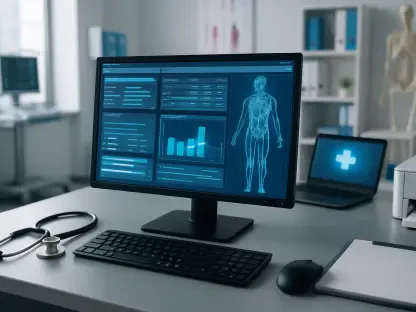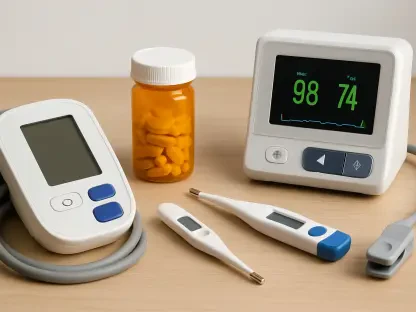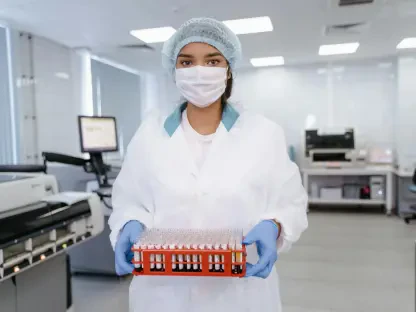The apheresis equipment market is poised for significant transformation due to the integration of Artificial Intelligence (AI). As the demand for blood component separation technologies rises, AI promises to bring about unprecedented advancements in efficiency, accuracy, and patient care. This article delves into how AI will revolutionize this vital sector, examining technological advancements, market growth, and regional impacts.
AI Integration in Apheresis Equipment
Enhancing Accuracy and Monitoring
AI is enhancing the accuracy of apheresis procedures by optimizing the separation processes. Algorithms are now capable of more precise collection of blood components, ensuring optimal patient outcomes. This technological advancement significantly reduces errors and improves the reliability of procedures. Greater accuracy in blood component separation is critical for patients undergoing treatments for conditions that require frequent blood processing, such as leukemias and autoimmune disorders.
AI also elevates the monitoring capabilities of apheresis devices. Real-time data analytics enable medical professionals to track and adjust treatments as necessary, enhancing the overall quality of patient care. Monitoring parameters like blood flow rates, pressure readings, and cell counts in real time allows for prompt interventions that can mitigate complications. This dynamic adjustment capability ensures that treatments are tailored to each patient’s specific needs and conditions, improving the likelihood of successful outcomes.
Automation and Efficiency
Automation is at the core of AI’s impact on apheresis equipment. AI-driven systems can handle complex data-related tasks, freeing healthcare professionals to focus on direct patient care. This not only enhances efficiency but also leads to more personalized treatment plans. Automated data analysis helps in identifying patterns and predicting patient needs, which can further optimize the scheduling and execution of apheresis procedures.
AI technology also streamlines procedures through intuitive interfaces and automated processes. The result is a significant reduction in the time required for each session, increasing the number of patients who can be treated effectively within the same timeframe. The time savings are especially beneficial in busy healthcare settings, where maximizing the use of available resources is crucial. This efficiency not only improves patient throughput but also reduces the wear and tear on the equipment, potentially extending its operational life.
Market Growth Drivers
Increasing Incidence of Blood-Related Disorders
The rising prevalence of hematologic disorders is a primary driver for the demand for advanced apheresis equipment. As more individuals seek treatment for conditions like lymphoma, leukemia, and myeloma, the need for efficient blood separation technologies increases. Effective management of these disorders often depends on timely and accurate separation of blood components, which is where modern apheresis devices become invaluable.
AI’s role in improving these treatments is crucial. By enhancing the capabilities of apheresis devices, AI helps meet the growing demand and improves patient outcomes, further driving market growth. Advanced AI algorithms can optimize the extraction ratios, ensuring that an adequate number of healthy blood cells are left in the patient’s system while effectively removing the targeted components. This level of precision supports better chronic condition management and has the potential to improve patients’ quality of life.
Technological Advancements
AI is at the forefront of technological advancements in the apheresis market. Innovations in AI algorithms and machine learning enhance the performance of apheresis devices, making them more effective and reliable. These AI-driven improvements encompass not only the mechanical operations of the devices but also the data analytics associated with each procedure, enabling comprehensive patient monitoring and adjustment.
These advancements are particularly significant in developing regions where the improvement of healthcare infrastructure enables broader access to state-of-the-art medical treatments. Enhanced AI capabilities ensure that these areas can effectively cope with increasing demands. For emerging markets, adopting such advanced technologies implicates a leap toward better healthcare outcomes and patient management. This adoption fosters a competitive market environment that encourages further innovation and investment in these regions.
Regional Impact
North America’s Dominance
North America holds the lion’s share of the apheresis equipment market, driven by substantial healthcare spending and a strong presence of key players. AI integration in medical devices is more advanced in this region, contributing to its market dominance. The structured regulatory environment and significant investment in healthcare innovations ensure rapid uptake and deployment of new technologies, including AI.
The U.S., with its cutting-edge healthcare systems, is at the forefront of adopting AI in apheresis equipment. The focus on improving patient outcomes and operational efficiency ensures sustained market leadership. Hospitals and clinics have access to the latest AI-driven devices, supported by a strong network of technical experts and healthcare professionals proficient in their use. This robust framework enables rapid integration of AI advancements into standard care practices.
Asia-Pacific’s Rapid Growth
The Asia-Pacific region is witnessing rapid growth in the apheresis equipment market. Economic development in countries like China, India, and Japan is bolstering healthcare infrastructure, making it a significant area for market expansion. As the economies grow, healthcare investments increase, leading to the development of advanced medical facilities equipped with the latest technologies, including AI.
AI plays a vital role in this growth, as the region’s healthcare systems embrace advanced technologies to manage the increasing prevalence of blood-related disorders. Improved access to AI-driven apheresis equipment ensures better treatment and patient care. The adoption of AI in medical devices helps these countries bridge the gap in healthcare quality and access, offering more precise and effective treatments to a larger population.
Key Market Segments
Disposable Apheresis Kits and Devices
Within the apheresis equipment market, disposable apheresis kits dominate due to their vital role in ensuring safe and sterile procedures. The demand for these kits is driven by the need to prevent infection and cross-contamination. Single-use kits effectively eliminate the risks associated with device reuse, crucial in maintaining high standards of patient safety and care.
On the other hand, apheresis devices are experiencing the fastest growth. Innovations in AI and healthcare infrastructure are propelling this segment’s expansion, catering to the increasing number of apheresis procedures. Enhanced device functionality through AI not only improves the precision of the procedures but also simplifies the operation and maintenance of the equipment. This makes the newer devices more attractive to healthcare providers looking to upgrade their services.
Plasmapheresis and Leukapheresis
Plasmapheresis holds the largest market share, primarily due to the treatment of conditions like lymphoma and leukemia. AI advancements are enhancing the efficiency and effectiveness of these procedures, making them more accessible and reliable. AI’s capability to refine and optimize plasmapheresis processes ensures that plasma collection is both thorough and fast, which is key for patients needing regular treatments.
Leukapheresis, meanwhile, is anticipated to grow at the fastest CAGR. The demand for individualized medicine cell therapies, such as CAR-T, is on the rise, and AI’s role in facilitating these advanced treatments is crucial. AI-enhanced leukapheresis devices provide the precision and adaptability needed for extracting specific cell types necessary for these bespoke therapies. The growing success of CAR-T therapies continues to drive demand for advanced leukapheresis technologies that offer greater control and efficiency.
Future Prospects
Enhanced AI Capabilities
The future of the apheresis equipment market lies in the continuous advancement of AI capabilities. As AI technology becomes more sophisticated, its applications in apheresis will expand, further enhancing treatment efficiency and patient outcomes. Future AI models capable of deeper learning and better pattern recognition will increase procedural accuracy and predictive maintenance of the devices. These improvements will optimize every aspect of the apheresis process from collection efficiency to downtime reduction.
Advancements in AI are expected to lead to more integrative solutions where apheresis systems can communicate with other healthcare technologies and electronic health records (EHRs). This interoperability will allow seamless data transfer and comprehensive patient care, leveraging AI’s ability to analyze extensive datasets to identify treatment efficiencies and patient-specific adjustments that will enhance therapeutic outcomes.
Strategic Industry Initiatives
The apheresis equipment market is on the brink of significant transformation, driven by the introduction of Artificial Intelligence (AI). With an increasing demand for blood component separation technologies, AI is set to deliver groundbreaking improvements in efficiency, precision, and patient care. This article explores how AI will overhaul this crucial sector by focusing on technological advancements, market growth, and regional impacts.
AI’s potential to enhance apheresis equipment is vast. It can optimize the separation processes, reduce human error, and ensure that blood components are accurately separated and delivered. By integrating AI, machines can learn and adapt, leading to faster and more effective operations. This not only heightens productivity but also improves patient outcomes by providing more precise treatments.
Market growth is also anticipated as AI makes these technologies more accessible and user-friendly. Regions investing in healthcare technology are likely to see a surge in demand for AI-integrated apheresis equipment. Institutions will benefit from reduced operational costs and improved healthcare services, creating a positive loop of investment and innovation.
Ultimately, AI’s integration into apheresis equipment promises a brighter future for both providers and patients. The advancements in efficiency, accuracy, and care will foster a more robust and responsive healthcare system worldwide.









